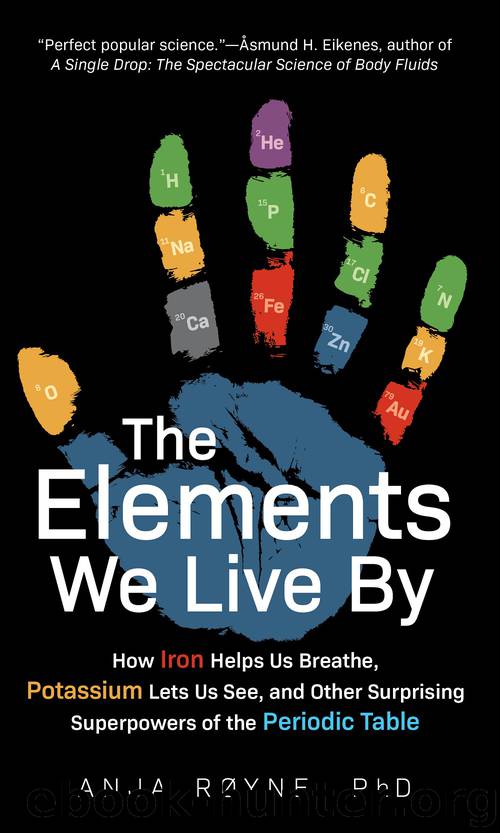The Elements We Live By by Anja Røyne

Author:Anja Røyne
Language: eng
Format: epub
Publisher: The Experiment
Published: 2020-05-05T17:11:49+00:00
plastic after oil
Plastic is everywhere. I have plastic in my toothpaste tube, kitchen utensils, furniture, clothes, bike, car, skis, phone, and computer. Before we started using oil-based plastics, millions of turtles, elephants, and humans were killed to meet our needs for polymer materials. At that time, there were around 1.5 billion people on Earth. Today there are more than 7 billion of us, and it’s been estimated that plastic production will increase to 1 billion metric tons annually by the end of this century. Producing this much plastic will require a quarter of today’s annual oil production. What would happen if we had to stop making plastic from fossil sources?
We’ve already made plastic products from cellulose and other natural polymers. The first Legos were made from cellulose, for example. Today, there are methods for making single fibers of cellulose, which can provide extremely strong materials in combination with other polymers. Similarly strong fibers can be made from chitin, which is found in the shells of shrimp and crabs. Researchers are also working on making plastic products from lignin (the other large molecule we get from wood) and by processing polymers from plant oils. These raw materials are far more abundant in nature than natural rubber and gutta-percha. In theory, it should be possible to produce all the products we need from natural raw materials.
We can also use microorganisms to make new polymers for us. We’re already able to buy plastics made from lactic acid, which is produced by bacteria or fungi that eat sugar and starch. Other bacteria make excellent cellulose fibers. When researchers have studied life-forms that live under extreme conditions such as inside volcanoes or in the deep sea, they’ve found organisms that are robust enough to function well in industrial processes. New advances in biotechnology have given us the opportunity to manipulate the genes of bacteria and fungi so they can produce more of what we want or even create new materials.
Now, the challenge for scientists and industry lies in exploring all possibilities for producing materials from renewable polymer sources, as has been the case over the past century for petroleum products. At the same time, we need to figure out how to get enough plant-based raw materials to produce the plastic we need without overloading ecosystems and without it happening at the expense of food production. If we manage to do all of these things, our descendants might also be able to enjoy all of the benefits plastics offer us today.
Download
This site does not store any files on its server. We only index and link to content provided by other sites. Please contact the content providers to delete copyright contents if any and email us, we'll remove relevant links or contents immediately.
| Concrete | Extraction & Processing |
| Fracture Mechanics | Materials Science |
| Metallurgy | Polymers & Textiles |
| Strength of Materials | Testing |
Whiskies Galore by Ian Buxton(40332)
Introduction to Aircraft Design (Cambridge Aerospace Series) by John P. Fielding(32338)
Small Unmanned Fixed-wing Aircraft Design by Andrew J. Keane Andras Sobester James P. Scanlan & András Sóbester & James P. Scanlan(32141)
Craft Beer for the Homebrewer by Michael Agnew(17446)
Turbulence by E. J. Noyes(7039)
The Complete Stick Figure Physics Tutorials by Allen Sarah(6638)
Kaplan MCAT General Chemistry Review by Kaplan(6054)
The Thirst by Nesbo Jo(5785)
Bad Blood by John Carreyrou(5769)
Learning SQL by Alan Beaulieu(5411)
Weapons of Math Destruction by Cathy O'Neil(5036)
Man-made Catastrophes and Risk Information Concealment by Dmitry Chernov & Didier Sornette(4736)
iGen by Jean M. Twenge(4702)
Digital Minimalism by Cal Newport;(4541)
Life 3.0: Being Human in the Age of Artificial Intelligence by Tegmark Max(4507)
Audition by Ryu Murakami(4099)
1,001 ASVAB Practice Questions For Dummies by Powers Rod(4038)
Electronic Devices & Circuits by Jacob Millman & Christos C. Halkias(4027)
Pale Blue Dot by Carl Sagan(4001)
